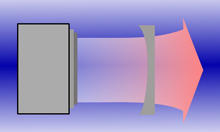Thin Disk Laser Laboratory
In the last 20 years, there has been a large increase in the output power and brightness of high power solid-state lasers. The development of solid-state lasers with kilowatt-level average power and diffraction-limited beam quality has primarily been enabled by three elements: high power and efficient laser diodes, ytterbium-doped laser gain media with low quantum defect, and advanced laser geometries that have large surface area to volume ratios. Thin disk lasers share the first two elements with fiber lasers; however the last point offers an interesting comparison. Whereas fiber lasers achieve a large surface area to volume ration with long gain length and small cross-section, thin disk lasers utilize large aperture with minimal thickness. Both geometries are capable of multi-kW average power, high optical-to-optical efficiency, and significantly less thermal lensing than more conventional rod-shaped solid-state gain media. Importantly, the significantly larger aperture of the thin disk geometry also enables the generation of high energy and high intensity laser pulses.
As a member of the Townes Laser Institute, the Laser Plasma Laboratory (LPL) has invested in thin disk lasers as part of advanced laser development efforts. In 2010 LPL began an active partnership with Trumpf GmbH, the leading manufacturer of thin disk laser systems. We currently have a joint program to develop high-energy pulsed laser systems using Trumpf kW-class laser systems, and to investigate the utility of such systems in applications such as the generation of extreme ultraviolet (EUV) light and optical parametric chirped pulse amplification (OPCPA) pumping.
This effort takes advantage of LPL'ss broad capabilities and experience in laser development, and established facilities such as Thermal Lens Characterization. This thin disk research also benefits from the investment of the Townes Laser Institute in ceramic laser gain media. Ceramic gain media offer the potential to further improve thermal management in thin disk lasers, by enabling the use of new laser gain media and by providing significantly greater freedom to engineer the thermal properties of the disk.

